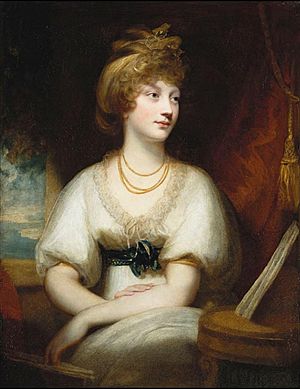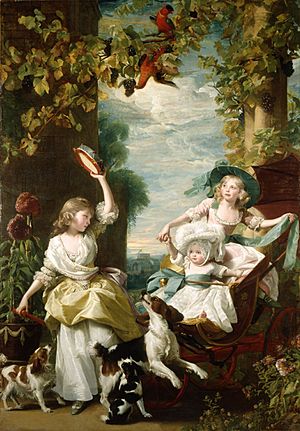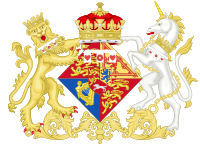Princess Amelia of the United Kingdom facts for kids
Quick facts for kids Princess Amelia |
|
|---|---|

Portrait by Sir William Beechey
|
|
| Born | 7 August 1783 Royal Lodge, Windsor |
| Died | 2 November 1810 (aged 27) Augusta Lodge, Windsor |
| Burial | 13 November 1810 Royal Vault, St George's Chapel, Windsor Castle |
| House | Hanover |
| Father | George III, King of the United Kingdom |
| Mother | Charlotte of Mecklenburg-Strelitz |
| Top - 0-9 A B C D E F G H I J K L M N O P Q R S T U V W X Y Z |
Princess Amelia (born 7 August 1783 – died 2 November 1810) was the youngest of King George III of the United Kingdom's 15 children. Her parents were King George III and Queen Charlotte. She was their sixth daughter. Amelia was the first of their daughters and third child to pass away before them.
Early Life of Princess Amelia
Princess Amelia was born on 7 August 1783, at the Royal Lodge in Windsor. She was the only one of her parents' 15 children born at Windsor Castle. Many people say she was her father's favorite child. He lovingly called her "Emily."
Amelia was born after her two older brothers, Octavius and Alfred, had passed away. This meant there was a gap of almost six years between Amelia and her next oldest sister, Princess Sophia. Amelia was also much younger than her oldest siblings. Her oldest brother, George, was 21 years older than her. Her oldest sister, Charlotte, was nearly 17 years older.
Amelia was christened, which is a special church ceremony, at the Chapel Royal in St James's Palace. This happened on 17 September 1783. Her godparents were her eldest brother, the Prince of Wales, and her two eldest sisters, the Princess Royal and Princess Augusta Sophia. She was the fifteenth child in her family to be christened there. She was later confirmed by the Archbishop on 24 December 1799.
Amelia's birth brought hope after the death of her brothers and the end of a war. People expected great things from her. Her oldest sister wrote that Amelia was "one of the prettiest children I have ever seen." Everyone thought she would be as beautiful and charming as her brother Octavius, who had been her father's previous favorite. Because her two brothers had died, Amelia became her father's special favorite.
From a young age, Amelia understood her royal position. There's a story that when a famous actress wanted to kiss the baby Amelia, the princess "instantly held her little hand out to be kissed." This shows how early she learned about being a royal. When Amelia was three, Fanny Burney, who worked for the Queen, said that the princess could act "decorous and dignified" when meeting strangers. She seemed to know her high rank. Burney even called her "the little idol."
As the youngest of 13 children who survived, Amelia spent most of her time with her sisters Mary and Sophia. They lived in different royal homes. These three younger princesses did not get as much attention from their parents as their older sisters had. They spent a lot of time away from the King and Queen, mostly communicating through letters.

It seems the three youngest princesses were more playful than their older sisters. This was clear when they posed for a painting in 1785. An artist named John Singleton Copley had a very hard time getting the dogs, birds, and especially the three royal children to sit still. He never painted another royal portrait after that!
The education given to Mary, Sophia, and Amelia was not as carefully planned as their older sisters' education. Amelia was only five years old when her father first became ill with a mental condition. Because of her father's health problems, she never had the same close and loving family life that her older sisters had when they were young.
Adulthood and Challenges
Before 1788, King George had planned to take his daughters to Hanover to find them suitable husbands. But he worried about his sisters' unhappy marriages. He once said, "I cannot deny that I have never wished to see any of them marry: I am happy in their company."
However, the King suffered his first period of mental illness in 1788, when Amelia was five. He had more periods of illness in 1801 and 1804. This stopped any talk of marriage for his daughters. The Queen was also worried that talking about marriage would make the King's illness worse. She wanted her daughters to stay close to her.
Amelia and her sisters were very protected and isolated. This made it hard for them to meet suitable young men to marry.
Illness and Final Years
In 1798, Princess Amelia began to feel pain in her knee. She was sent to the seaside town of Worthing to get better. She wrote to her father that the sea baths were helping. The next year, she felt well enough to join her family in Weymouth. There, she loved spending time with her niece, Princess Charlotte.
Throughout her life, Amelia was often unwell. When she was 15, she started showing signs of what was later believed to be tuberculosis, a serious illness.
In 1801, Amelia went to Weymouth again for her health. While there, she became close to Charles FitzRoy, an officer who was 21 years older than her. Amelia fell in love with him and wanted to marry him. The Queen knew about their close relationship but did not stop it. They hoped the King would not find out, as it might make his mental illness worse.
Amelia never gave up hope of marrying FitzRoy. However, she knew she could not legally marry him because of the Royal Marriages Act 1772. This law, passed by her father, made it difficult for royals to marry without permission. She later told her brother Frederick that she considered herself married to FitzRoy. She even used the initials A. F. R. (Amelia FitzRoy).
In 1808, Amelia became very ill with measles. The sad atmosphere at home in Windsor made her feel even worse. King George decided to send Amelia to Weymouth again, with her sister Mary. Her health improved only a little, but she found comfort in resting quietly. In 1809, she could take short walks in the garden.
This improvement did not last. In August 1810, her pain grew much worse. In October, she got a skin infection called St. Anthony's fire (erysipelas). This meant there was no hope for her recovery, and she had to stay in bed from October 25th. The King would ask her doctors about her condition many times a day.
Amelia lived for a few more days, cared for by her devoted sister, Mary. She passed away at noon on 2 November 1810. This was also her brother Edward's birthday.
Before she died, Princess Amelia had a special ring made for the King. It had a lock of her hair under crystal, surrounded by diamonds. It is said that the King cried when he received it. In her will, Amelia left all her belongings to Charles FitzRoy. Amelia was buried in the Royal Vault at St George's Chapel, Windsor Castle in Windsor. Her oldest brother, who later became King George IV, reportedly asked for a death mask of her face.
After Amelia's Death
After Amelia died, George Villiers, who managed the King's finances, tried to get money from the King and Queen. He used letters that belonged to Amelia. This happened after a large sum of money under his control went missing.
Amelia's death is believed to have made her father's health worse. It led to his full mental illness and the start of the Regency Act of 1811. This act meant his son, the Prince of Wales, ruled as regent. According to his doctor, the King would cry out for Amelia. He also had a delusion that a healthy Amelia was living in Hanover with a large family, where she would "never grow older and always be well."
Amelia was described as a beautiful girl with ruby lips and auburn hair. Some said she was the "most turbulent and tempestuous of all the Princesses." However, she was also known to be kind, lively, unselfish, and smart. Her sister-in-law, Princess Caroline, who usually disliked her husband's family, called Amelia the "most amiable of the bunch."
Amelia was a favorite of both the Prince of Wales and the Duke of Sussex. The Duke called her a "lovely creature." Amelia loved the Prince of Wales very much. She once told him she loved him more than her other brothers. He also loved her deeply and was heartbroken when she died. He was so affected that after her funeral, he could only sleep in a room lit by several candles. He would also cry at the mention of her name, even more than three years after she passed away.
Titles and Symbols
Titles and Styles
From birth, Princess Amelia was known as Her Royal Highness The Princess Amelia. This title showed she was a daughter of the monarch.
Arms
From 1789, as a daughter of the King, Amelia used the royal coat of arms. Her arms had a special design to show she was a princess. It was a silver label with three points. The middle point had a red rose, and the outer points each had a red heart.
See also
 In Spanish: Amelia del Reino Unido para niños
In Spanish: Amelia del Reino Unido para niños



